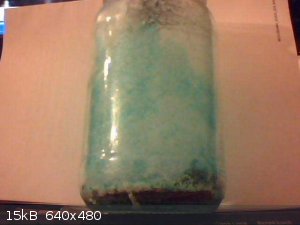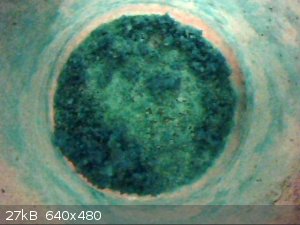pinkamena
Harmless

Posts: 2
Registered: 23-8-2016
Member Is Offline
Mood: No Mood
|
|
Ammonium chromate, what the fuck has happend there?
Okay, I was just neutralising a concentrated chromic acid solution with ammonia to get ammonium chromate, and added about 100% excess ammonia. The
next day, ammonium chromate crystallised out, which is not really unusual, but a few hours later when I looked at it, and there were super fluffy
orange crystals only on one side of the beaker all the way to the top. The crystals really were like a mushroom or something like that, I have
absolutely no explanation for that. Has anyone an idea of how that could happen, the solution was alkaline, and there were no chloride ions present,
so there is no chance that some volatile CrO2Cl2 has formed, and there were only crystals in the beaker, nowhere else, so I don't think that there was
any volatile Cr 6+ compund escaping.
|
|
|
Texium
|
Thread Moved
12-11-2016 at 20:50 |
Rhodanide
Hazard to Others
  
Posts: 348
Registered: 23-7-2015
Location: The 80s
Member Is Offline
Mood: That retro aesthetic
|
|
Quote: Originally posted by pinkamena  | | Okay, I was just neutralising a concentrated chromic acid solution with ammonia to get ammonium chromate, and added about 100% excess ammonia. The
next day, ammonium chromate crystallised out, which is not really unusual, but a few hours later when I looked at it, and there were super fluffy
orange crystals only on one side of the beaker all the way to the top. The crystals really were like a mushroom or something like that, I have
absolutely no explanation for that. Has anyone an idea of how that could happen, the solution was alkaline, and there were no chloride ions present,
so there is no chance that some volatile CrO2Cl2 has formed, and there were only crystals in the beaker, nowhere else, so I don't think that there was
any volatile Cr 6+ compund escaping. |
You should change the title.
Besides that, I have no idea.
Edit: Actually, By neutralizing the Chromic acid, you probably created some heat, causing turbidity, and maybe subsequently moving the crystals
around? (Other users feel free to correct me, for I could be incorrect!)
Edit2: Add some pics if you can! (That is, if you still have the formation intact!)
[Edited on 14-11-2016 by Tetra]
[Edited on 14-11-2016 by Tetra]
|
|
|
phlogiston
International Hazard
    
Posts: 1376
Registered: 26-4-2008
Location: Neon Thorium Erbium Lanthanum Neodymium Sulphur
Member Is Offline
Mood: pyrophoric
|
|
Sometimes you can have a crust of crystals form on the sides of the container which then wicks up the saturated solution by capilary action. As the
solvent evaporates on the surface of the mass, it deposits more salt. Odd shaped crusts can sometimes form in that way.
I don't know if that is what happened in your case, but your description sounds like it might have.
[Edited on 14-11-2016 by phlogiston]
-----
"If a rocket goes up, who cares where it comes down, that's not my concern said Wernher von Braun" - Tom Lehrer |
|
|
wg48
National Hazard
   
Posts: 821
Registered: 21-11-2015
Member Is Offline
Mood: No Mood
|
|
Yes the crystals form above the solution surface due to capillary action up its walls. Its not necessarily even perhaps due to how clean the sides of
the container are or if one side of the container is at a different temperature.
Below is pic of some waste solution that evaporated in a jar. It was only about 1/2 to 2/3 full.

and a pic of the bottom of the jar

[Edited on 14-11-2016 by wg48]
|
|
|
woelen
Super Administrator
        
Posts: 7977
Registered: 20-8-2005
Location: Netherlands
Member Is Offline
Mood: interested
|
|
Indeed crystals, formed near the surface, sticking to the glass, suck up additional liquid, which evaporates and leaves more solid. This can grow so
large that it even grows out of the beaker, onto the table around it. This type of crystals is less pure than those, formed in the liquid. Any
non-volatile impurities, present in the liquid, will also be in the crystals above the liquid. If in your case you started with pure chromic acid and
pure/clean ammonia, then the fluffy crystals above the surface of the liquid will be pure as well.
You did not make ammonium chromate in this way, but you made ammonium dichromate. The former is golden yellow, the latter is bright orange. Ammonium
chromate is not stable, it loses ammonia on standing in contact with air, leaving ammonium dichromate behind. Making pure ammonium chromate is very
difficult. I never managed to obtain the pure compound, it always is strongly contaminated with ammonium dichromate.
|
|
|
Rhodanide
Hazard to Others
  
Posts: 348
Registered: 23-7-2015
Location: The 80s
Member Is Offline
Mood: That retro aesthetic
|
|
Quote: Originally posted by woelen  | Indeed crystals, formed near the surface, sticking to the glass, suck up additional liquid, which evaporates and leaves more solid. This can grow so
large that it even grows out of the beaker, onto the table around it. This type of crystals is less pure than those, formed in the liquid. Any
non-volatile impurities, present in the liquid, will also be in the crystals above the liquid. If in your case you started with pure chromic acid and
pure/clean ammonia, then the fluffy crystals above the surface of the liquid will be pure as well.
You did not make ammonium chromate in this way, but you made ammonium dichromate. The former is golden yellow, the latter is bright orange. Ammonium
chromate is not stable, it loses ammonia on standing in contact with air, leaving ammonium dichromate behind. Making pure ammonium chromate is very
difficult. I never managed to obtain the pure compound, it always is strongly contaminated with ammonium dichromate. |
Indeed, I have had that happen with Potassium Ferricyanide over the course of a year.
|
|
|
mayko
International Hazard
    
Posts: 1218
Registered: 17-1-2013
Location: Carrboro, NC
Member Is Offline
Mood: anomalous (Euclid class)
|
|
I had an outgrowth of this sort, trying to dry copper chloride solution with sodium hydroxide. The lye deliquesced and developed a feathery tree-like
growth which eventually invaded the copper chloride container. There's a picture in this post:
https://www.sciencemadness.org/whisper/viewthread.php?tid=26...
al-khemie is not a terrorist organization
"Chemicals, chemicals... I need chemicals!" - George Hayduke
"Wubbalubba dub-dub!" - Rick Sanchez
|
|
|
|